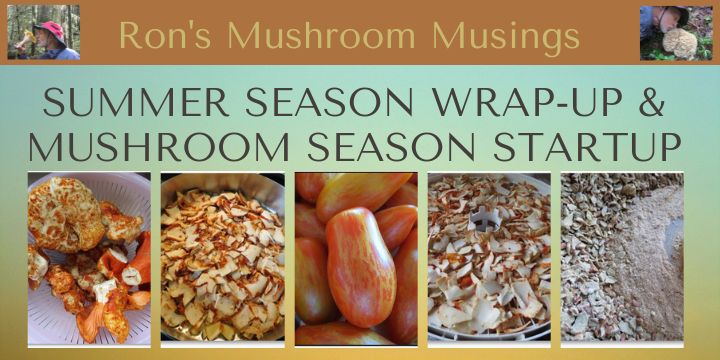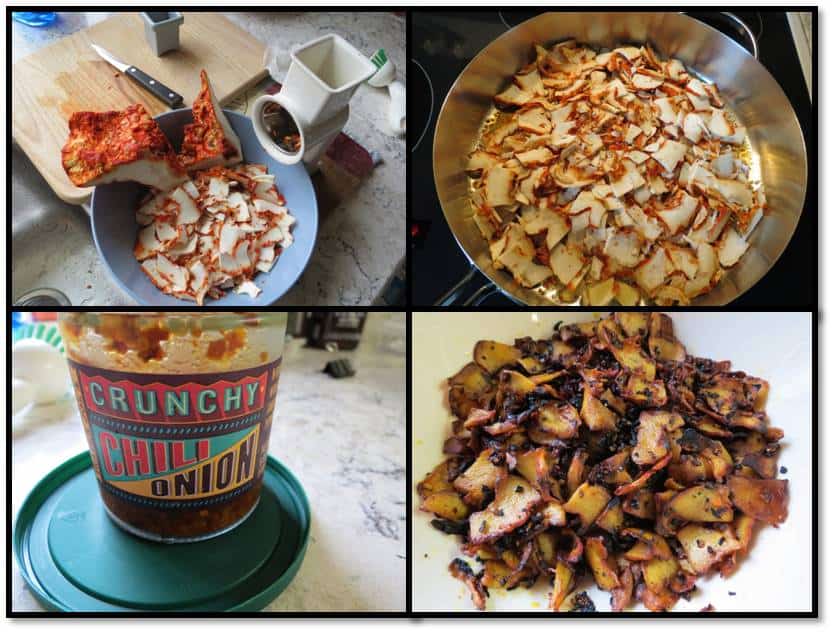Summer Season Wrap-Up & Mushroom Season Startup

It’s an odd feeling to be writing an article about gardening and mushrooming while our sky is filled with smoke and we’re being advised to stay inside for health reasons. Although, the staying inside advice is what motivated me start writing this article today rather than next weekend. In any event, I’d first like to report on our amazing 2022 gardening season that didn’t go completely as planned. I had purchased seeds in January based on last year’s super early hot May weather and long growing season. Well, let me just say that my assumptions of having another 2021 hot weather pattern this summer were vastly over predicted. The seeds I started in April under grow lights were already setting fruit before it was warm enough to plant them outside.

Last year we were picking Glacier tomatoes off our plants in mid June, but not this year. I also thought Oregon’s new, long hot summers would be great for growing watermelons and cantaloupes. Did I mention my growing season assumptions for 2022 may have been a little overly optimistic. I have eaten some very tasty fried green tomatoes but does anyone have a recipe for fried green watermelon?

While I may have made a few questionable seed choices, growing a tomato called Prairie Fire was not one of them. This medium sized plum shaped tomato is loaded with great flavor and a nice burst of sweetness. Bred by Aaron Whaley, it’s extremely enjoyable to eat and displays a very bright array of colors. At this point I must state that I in no way have any personal connection to Mr. Whaley nor have I received any lobbying dollars or promotional fees for endorsing this amazing and delicious tomato.

While I have no intent on belaboring my 2022 tomato experiences, I would be remiss if I didn’t write about the litchi Tomato that I acquired from Baker Creek Heirloom Seeds. Actually, this serves as both a review of this tomato and a warning to those who might want to grow it in the future. While I really enjoy trying new and different fruits and vegetables, this one is neither a kid friendly plant nor an adult friendly plant for that matter. Every part of this plant is covered in so many thorns that it would make a blackberry vine envious. I can personally attest to that as my arm looked like it was shoved between two brawling cats when I had only reached through the plant to pull out a weed. Just brushing my arm against a few thorny leaves was all it took. I must also state that the flavor of the fruit is quite overrated and not really worth the garden space. That said, if you want amazing looking flowers and enjoy growing dangerous plants, this one may be for you. Once again, I must state that I in no way have any personal connection to Baker Creek nor have I received any lobbying dollars or promotional fees for endorsing one of their listed, and quite formidable tomato seed offerings.
As for our Oregon mushroom status, we are still in the very early part of mushroom hunting season. Until we encounter several good rain events (2+ inches), we are pretty much left with selecting from a few early fruiters. This group primarily consists of Chicken of the Woods (Laetiporus conifericola); Lobster Mushroom (Hypomyces lactifluorum) and its non-parasitized host called the Short-Stemmed Russula (Russula brevipes); the Shrimp Russula (Russula xerampelina), and mostly other edible species in the genus Russula. Depending on where you look, you might find some stunted Chanterelles that have jumped the gun but ran out of moisture to fully develop. We have seen a handful of these sad looking mushrooms at Market of Choice selling for $49.99 a pound (good luck with that). Just be very careful if you pick small, underdeveloped mushrooms as color, gill structure, and other characteristics may be indistinguishable from inedible mushrooms at that stage of development.

So, how about those Lobster Mushrooms and what ‘s a good way to use them if you find them. As of this writing, unnamed sources have been finding them on the southern coast and even more so up toward the Astoria area where it has rained. That said, I have no doubt other coastal areas are now producing this mushroom as well. As for us, we have recently (within the last several weeks) tried and added two additional ways to use the Lobster Mushroom. But first, you’ll notice when you do pick these mushrooms, they typically include a copious amount of dirt and other forest debris attached to them. With all their nooks and crannies created by the parasitizing process, blowing on them, tapping on them, or just doing some light brushing can be an exercise in futility. To avoid being frustrated by gentle cleaning techniques, do what Sandy is doing in the photo to the left. Put a strainer in your drain, run the water at low volume, get a medium to hard toothbrush and scrub away the debris. If you need to, break it into pieces to get to those hard-to-reach spots. Don’t worry about water saturation as you’re going to slice these up and cook, bake, or dry them shortly anyway.

Our first and easy to make recipe is to take the cleaned mushrooms, unless you enjoy mushrooms ala debris, break them into pieces, and create slices of even thickness. I use a decades old but very reliable hand cranked Zyliss tabletop shredder/slicer/mincer. Using the slicer insert quickly gives you bite sized pieces of equal thickness and cleanup is easy. Using a good-sized skillet, heat up some oil, fresh or dried garlic, dried parsley, and some Trader Joe’s Chili/Onion Crunch to infuse a little spice and umami (you can’t go wrong when you’ve got umami). Then, add your mushrooms and fry them until nice and crispy. They make a great appetizer, side dish, or ingredient for a rice dish or any kind of quick stir-fry. I’d stay away from high moisture recipes as it may make the mushroom slices a bit soggy.

If we have more Lobster Mushrooms than we need for our meal, drying and making them into a seasoning powder has become very popular. For this you should actually use a dehydrator as other methods may take much longer and allow the mushrooms to discolor or perhaps spoil. We start by using our Zyliss to create the same type of slices as with our previous recipe. Spread the slices out evenly on the dehydration platters and dehydrate until totally dry and brittle. We use a food processor to grind the dehydrated pieces until it is a mix of powder and smallish pieces. We’ve found this blend gives you more mushroom flavor when added to soups, stews, or whatever you’re making. Just remember that although these pieces have been dehydrated they should really be cooked to fully break down their tough cell walls and make them more digestible. Lastly, I must state that I in no way have any personal connection to the DKSH Corporation, manufacturer of Zyliss, nor have I received any lobbying dollars or promotional fees for endorsing one of their products. Not that I wouldn’t mind getting a check from them now and then. DKSH, if you can hear me – release those checks now.
So, there you have it. Tomatoes, mushrooms, and things to do with them. As Sherlock Holmes would say “The game is afoot”, the mushroom season has begun and all we need now is some decent rainfall during September and October to really kick things off. Hopefully the rain will arrive sooner rather than later as we all could use some distractions right about now and you can’t do better than a physically and mentally restorative day hiking in the woods.
Welcome back, stay safe out there and successful mushroom hunting,
Ron (unless you dislike this article, then it’s Sandy)





